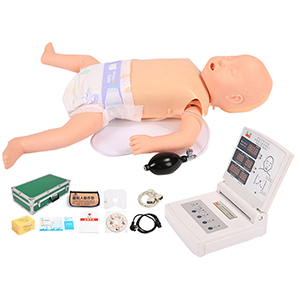Welcome to visitShanghai Chinon medical Model & Equipment Manufacturing Co., LTD
In the field of neonatal emergency care, a timely and precise response is critical to saving lives. In order to ensure that medical personnel have sufficient response ability and operational accuracy in the face of emergency situations, ** Advanced neonatal cardiopulmonary resuscitation simulator ** as an advanced training tool, with its high degree of imitation and versatility, can simulate a variety of neonatal first aid scenarios to help medical personnel comprehensively improve first aid skills.
1. Simulate common emergency situations of newborns

The Advanced Neonatal cardiopulmonary resuscitation simulator is capable of simulating a variety of neonatal first aid scenarios, including but not limited to:
- Neonatal asphyxia: simulates the apnea of infants caused by airway obstruction, and the medical staff needs to perform effective airway management and artificial ventilation.
Neonatal cardiac arrest: Simulates cardiac arrest in a newborn and trains personnel to perform cardiopulmonary resuscitation (CPR), ensuring accurate chest compressions and airway management.
- Premature birth of newborns: Simulate the physiological characteristics of premature infants and help medical staff master first-aid skills for premature infants, such as temperature maintenance and respiratory support.
- Cerebral hypoxia caused by neonatal asphyxia: Simulate neonatal cerebral hypoxia caused by asphyxia, and train personnel to perform oxygenation management and rapid resuscitation.
Through the simulation of these scenarios, medical personnel can practice first aid operations in a risk-free environment, familiarize themselves with emergency treatment in different situations, and ensure that they can respond quickly in actual first aid.
2. Real-time feedback and physiological response simulation
Through the built-in sensor and feedback system, the advanced simulator can adjust the physiological response of the simulated human body in real time according to the correct operation of the first aid. For example, the simulator can adjust indicators such as heart rate, breathing rate and oxygen saturation according to whether the CPR is correct or not, helping students to correct errors instantly and improve the accuracy of the operation. This feedback mechanism is the core advantage of simulated human, which is different from the traditional teaching model, and can significantly improve the students' first-aid ability.
3. Improve newborn emergency judgment ability
In an emergency, the judgment of the first responders is crucial. Advanced neonatal cardiopulmonary resuscitation simulators can not only simulate physiological responses, but also provide a variety of changing situations during simulated first aid. For example, the simulated human vital signs such as blood pressure and heart rate will change according to the effectiveness of different first aid measures, helping students learn how to adjust the treatment plan according to clinical performance in practical operation. This multi-level simulation training helps participants better understand the physiological changes of newborns and improve their clinical judgment skills.
4. Reduce first aid errors and improve clinical confidence
Through the simulated neonatal first aid scenario, the trainees can continuously practice and strengthen the technical operation, reducing the mistakes in the actual first aid. For example, when conducting airway management for newborns, simulators can show in real time whether the airway is successfully opened or whether artificial ventilation is correctly performed, effectively avoiding serious consequences due to improper operation. Studies have shown that medical personnel who receive simulation training can reduce the error rate of 25% to 30% in actual first aid, and significantly improve the success rate of first aid.
5. Widely used to improve training standardization
Due to the particularity and high risk of neonatal first aid skills, the advanced neonatal cardiopulmonary resuscitation simulator is not only suitable for beginners, but also helps experienced medical staff to review and improve their skills. This simulator is widely used in hospitals, first aid training centers, medical schools and other training places, and has become the core equipment of newborn first aid training standardization. By simulating different scenarios, training can achieve consistent and quantifiable standards to ensure training quality.
Conclusion
Advanced neonatal cardiopulmonary resuscitation simulator provides an efficient and operable learning platform for neonatal first aid training by virtue of its advantages of high simulation and multi-scenario simulation. It simulates a variety of common neonatal emergency scenarios, provides real-time feedback, and helps medical staff practice first aid skills multiple times in a risk-free environment, improving operational accuracy and clinical judgment. Through this training, medical personnel can be more confident and professional in the face of real first aid scenarios, thereby improving the success rate of first aid, reducing medical errors, and providing a more powerful guarantee for the life safety of newborns.
|
NEXTпјљCan the shoulder joint model provide more accurate clinical simulation training?
LASTпјљHow can tracheotomy nursing model improve the practical ability of emergency nursing? |
Return list |